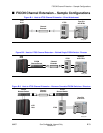
C-86 Sun Confidential: Internal Only 96257
Revision A
asynchronous. Not synchronized; not occurring at regu-
lar, predetermined intervals. Asynchronous transmis-
sions send one data character at a time, at irregular in-
tervals, rather than in one steady stream; a start bit and a
stop bit notify the receiver when the transmission begins
and ends. Contrast with synchronous.
ATA. Advanced Technology Attachment. Official name
for the disk drive interface standard commonly known as
Integrated Drive Electronics (IDE).
ATM. Asynchronous transfer mode. A networked tech-
nology based on transferring data cells or packets of a
fixed size.
attenuation. (1) The tendency for a signal to become
weaker and more distorted as its transmission distance
increases. (2) The loss or reduction of signal magnitude,
normally measured in decibels (dB).
AVMn. VTSS volatile memory storage cards; AVM4
cards have 4 MB capacity; AVM16 cards 16 MB.
B
back-end storage. The data storage portion of a stor-
age subsystem. In VTSS, the disk arrays.
background. A mode of operation where tasks are per-
formed on a low-priority basis to minimize the impact on
overall system performance. Contrast with foreground
.
backup. The process of producing a copy of a data set
for purposes of possible future recovery. Although tape is
the most common storage medium for backups, disk is
equally usable, although more expensive.
bandwidth. The amount of data that can be sent through
a network connection, measured in bits per second
(bps). High bandwidth allows fast transmission or high-
volume transmission.
base memory. Solid state memory in a controller that
stores the functional track directory (FTD) and other in-
ternal tables required for subsystem operations. Base
memory is not part of user-available cache.
battery backup unit (BBU). A system of batteries that
automatically supplies power to nonvolatile storage if AC
power is disrupted, to protect nonvolatile cache data. A
VTSS battery backup system has redundant batteries
that provide at least 72 hours of backup power.
battery charger unit (BCU). A VTSS device that contin-
uously charge a battery used to provide backup power.
baud rate. The transmission rate of a serial data stream
over communications lines, most often (but not always)
measured in bits per second (bps). Baud is a measure of
the number of signal-state changes per second; for ex-
ample, voltage or frequency changes.
BBU. See battery backup unit
.
BCU. See battery charger unit.
BER. Bit error rate.
beta test. The second test phase for new software (after
Alpha testing), wherein software is made available to us-
ers who evaluate it in what is expected to be typical op-
erating conditions.
binary. A numbering system which has 2 as its base and
uses 0s and 1s for its notation. Binary code is used by
computers because it works well with digital electronics
and Boolean algebra. In binary (base 2) numbering, the
number one is written as 1, the number two is written as
10, and the numbers three to ten are written as 11, 100,
101, 110, 111, 1000, 1001, 1010, etc.
bit. A binary digit of 0 or 1; a unit of computer information
equivalent to the result of a choice between two alterna-
tives (yes/no, on/off, etc.). Contrast with gigabit
, kilobit,
megabit.
block. Also called a packet
. (1) A contiguous section of
bits considered as a whole, especially in memory. On a
disk, a block is the data in one sector; in a modem data
transfer, a block is the bits between checksums. (2) A
group of bits transmitted as a unit and treated as a unit of
information; usually consists of its own starting and end-
ing control delimiter, a header, text to be transmitted, and
check characters at the end used for error correction.
Block sizes are usually a multiple of 512 bytes.
BOM. Bill of material.
bps. Bits per second. The number of bits of data that can
be transmitted in one second.
Bps. Bytes per second. The number of bytes of data that
can be transmitted in one second.
browser. A text- or graphic-based client program, such
as Netscape Navigator or Microsoft Internet Explorer,
that allows users to read hypertext documents on the
World Wide Web, and navigate between them.
buffered subsystem. A storage subsystem that pro-
vides separation between front- and back-end opera-
tions so data transfer synchronization is not required.
bus. A parallel electrical pathway, usually part of a circuit
board, that both connects and is shared by the parts of a
computer system (CPU, support circuitry, memory,
cards, etc.). Typically, the lines in a bus are dedicated to
specific functions, such as control, addressing, and data
transfer.
byte. A group of adjacent binary digits (bits) that a com-
puter processes as a single unit, or ‘word.’ Frequently
written as an eight-digit binary number or two-digit hexa-
decimal number. One letter of the alphabet in ASCII
code takes one byte. Contrast with gigabyte
, kilobyte,
megabyte.
C
CAB. Customer Advisory Board. At Sun StorageTek, a
group of customers who advise a corporate design team
about the features and functionality they would like to
have engineered into upcoming products.
cache. A block of memory that temporarily collects and
retains data before it is sent to a host or destaged to
back-end disk arrays, allowing quicker retrieval of fre-
quently-used data to improve overall system perfor-
mance. In VSM, all data is accessed through cache.
cache fast write (CFW). In VTSS, a write command
function wherein host data is written directly to volatile
cache memory without using nonvolatile storage (NVS),
and then is subsequently scheduled for destaging to
back-end disk arrays.
CAM. Central Archive Manager.
CAP. Cartridge access port of a Sun StorageTek library
unit.
CBT. Computer-based training.
CCR. Channel command retry. A channel procedure, ini-
tiated by a controller, that causes a channel command to
be repeated without breaking the command chain.
CCW. Channel command word.
CD-R. Compact Disc-Recordable.


















